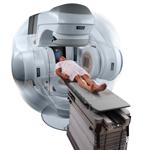
December 24, 2009 – Four cancer patients this past week became the first in Latin America to receive treatment using volumetric modulated arc therapy that potentially enables doctors to improve outcomes while extending modern care to more patients.
Doctors at Hope International Centro de Radioterapia of Guatemala are now treating four patients using RapidArc radiotherapy technology from Varian Medical Systems. One has recurring prostate cancer, one has a nasal cavity tumor, one has rectal cancer, and one patient has recurring glioblastoma multiforme, an aggressive type of brain tumor.
Clinicians at the center, which treats patients from across Central America, carried out the first treatment for a 66-year-old attorney whose prostate cancer recurred a year after it was first treated using robotic surgery. His first RapidArc treatment was delivered in 3.16 minutes using two arcs, or rotations, of the machine around the patient. By comparison, conventional IMRT (intensity-modulated radiation therapy) treatments would have taken eight to 10 minutes.
Using the image-guidance technology that is integral to the RapidArc treatment process, clinicians were able to detect a 2-3 mm displacement of the targeted tumor after they positioned the patient for his first treatment. “We could then make a very fine adjustment in the patient’s position, to ensure that we were accurately targeting the tumor and sparing surrounding tissues to the greatest extent possible,” said Luis A. Linares, M.D., medical director.
Dr. Linares and his medical team generated conventional IMRT treatment plans as well as RapidArc plans for all four patients, in order to compare and choose the one most likely to result in the best possible outcome. “In every case, the RapidArc plans were superior, as far as quality of the dose distribution was concerned,” Dr. Linares said. “We saw better coverage of the targeted tumor, and better normal tissue sparing. For the rectal cancer patient, doses to the bladder and femoral heads were significantly lower with the RapidArc plan. For the prostate cancer patient, RapidArc did a better job of protecting both the bladder and the rectum. And for the patient with recurrent glioblastoma, we saw a definite advantage to the RapidArc plan, in terms of protecting the optic nerve and optic chiasm.”
RapidArc delivers treatment in single or multiple arcs of the treatment machine around the patient and makes it possible to deliver image-guided, intensity modulated radiotherapy (IMRT) up to eight times faster than is possible with conventional IMRT. RapidArc technology directs the treatment beam at a tumor while continuously rotating around the patient. Conventional IMRT treatments are slower because they target tumors using a complex sequence of fixed beams from multiple angles.
Selected studies showing improved outcomes for prostate and head and neck cancer patients treated with IMRT as compared with other forms of radiotherapy and demonstrating the magnitude of tumor motion that can take place during a prostate cancer treatment.
For more information: www.hoperadioterapia.com, www.varian.com


 August 09, 2024
August 09, 2024 








